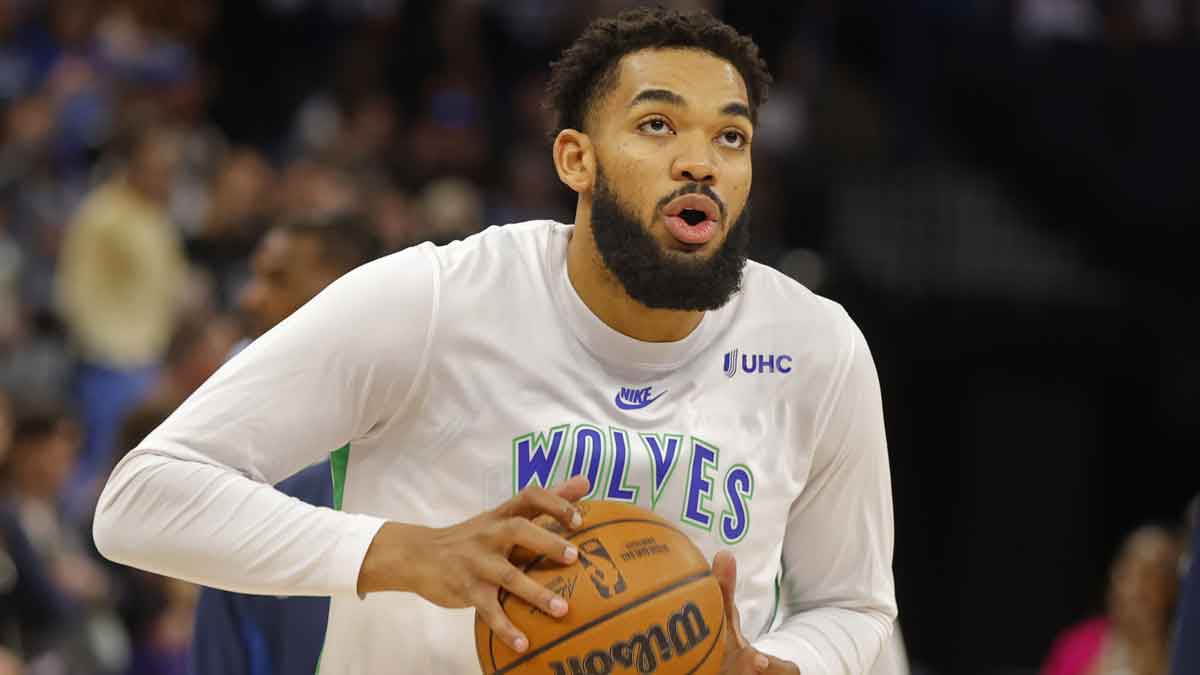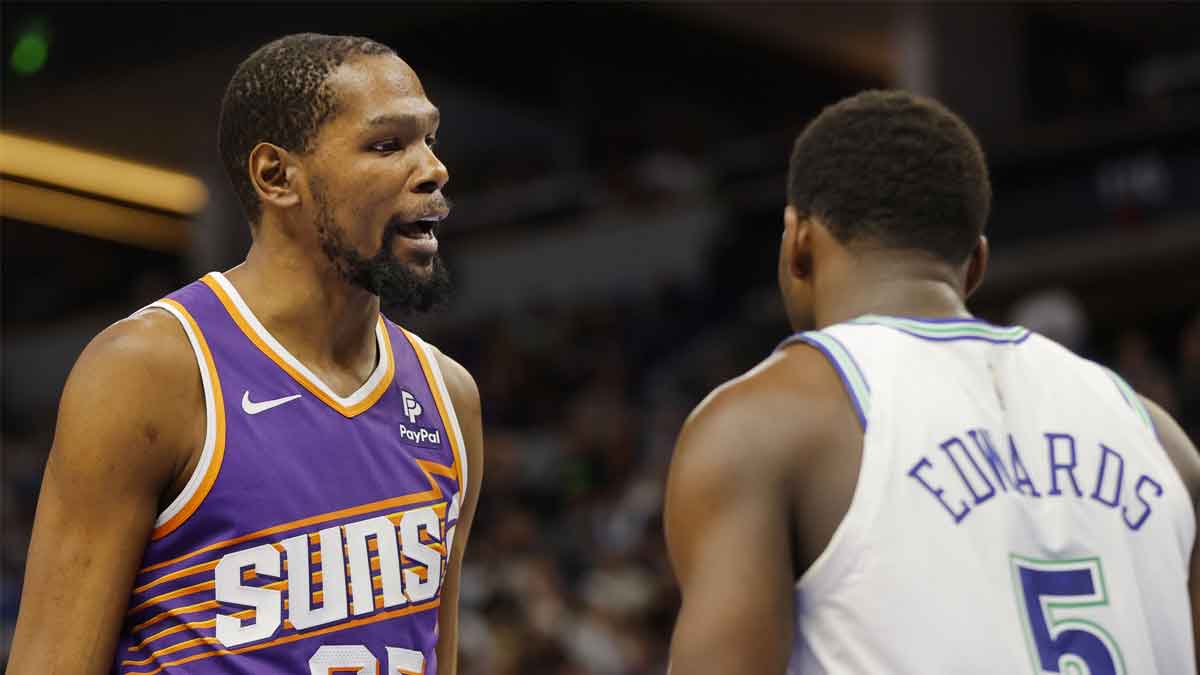
Game 82 of the regular season left Minnesota Timberwolves’ fans stunned. With major playoff implications on the line, the Wolves’ third and final game against the Phoenix Suns turned to disaster. Another horrible start for the Timberwolves led to 44 first-quarter points from the Suns, who capitalized off a rash of turnovers. Minnesota’s typically stellar play was nowhere to be seen in a 125-106 loss that set up a rematch with Phoenix in the first round of the playoffs.
The Wolves’ great defense is headlined by Rudy Gobert, but a pivotal, often overlooked aspect of their dominance on that end is screen navigation. The ability to stay connected to ball handlers through a series of picks has been Minnesota’s bread and butter defensively all season long. However, the Suns made quick work of the Wolves with their HORNS action, with Phoenix featuring one shooter and a big man as the main screen-setters.
As a result, not only does Minnesota have to worry about Devin Booker, Kevin Durant and Bradley Beal getting hot, they also have to prevent Grayson Allen finding himself wide open on these actions as well as limiting Jusuf Nurkic as a roll man.
The Suns’ offense is a joy to watch. It’s an even tougher task for Minnesota to defend with their unique personnel. Karl-Anthony Towns at the four is a problem Phoenix will look to exploit in the first round of the playoffs. KAT’s taken massive strides forward this season defensively. However, this series is going to show some of his deficiencies on that side of the ball.
KAT’s perimeter defense looms large

While most people imagine great defense as getting stops one-on-one, that’s really not the heart of great team defense. Maneuverability around screens, positional flexibility and rim protection really sums up great defense in today’s game.
As a seven-footer, Towns has been asked to do things these past two seasons that he’s never done. One of those areas is defending pick-and-roll ball handlers. Accustomed to being the five man for most of his career, he’s used to defending the other half of pick-and-rolls. Teamed with Gobert up front, the Suns will look to exploit Towns out in space with their stars in the first round of the playoffs.
Suns’ usage of Grayson Allen and Jusuf Nurkic as screeners presents a lot of problems for the Wolves’ defense
Free switching this Horns set makes KAT have to navigate screens (hasn’t been good all year – think SAC/NOLA)
If they don’t switch though, then Grayson Allen likely… pic.twitter.com/OHXTVaHIPq
— Sheldon Wohlman (@3swohlman) April 16, 2024
In the above clip , the Suns use Grayson Allen as the initial screener. In hopes of preventing Allen from getting a wide open look from three, the Timberwolves switch. As a result, Towns now is forced to guard Beal out in space. Again, though, the issue isn’t isolation defense, it’s screen navigation.
Towns is then screened again by Nurkic. With Gobert in his typical drop coverage, it is mandatory for KAT to chase over the screen and to stay attached to Beal’s hip. However, the seven-foot big man is not capable of doing so, a deficiency that haunted the Timberwolves all season.
‘Zoom’ actions , common across the league but favored by teams like the Sacramento Kings and New Orleans Pelicans, have been long-time indicators that this is a giant flaw.
Here’s KAT getting hung up on the DHO that Barnes missed pic.twitter.com/2cqDUe89Zl
— Sheldon Wohlman (@3swohlman) March 2, 2024
As a result of their inability to defend Phoenix using a variety of screen-setters, the Timberwolves’ defense has been tested like never before—and it’s failing. Their loss to the Suns in the regular season finale marked a series sweep. However, Minnesota has a few answers to this problem if they can lean into these solutions.
Rudy Gobert must be more than a rim-protector
While the Wolves would prefer to have Gobert protecting the paint all series long, the reality doesn’t allow for that. First of all, the Suns ranked 28th in points in the paint across the entire NBA. The only two teams worse were the Memphis Grizzlies and Portland Trail Blazers. While Gobert’s shot-blocking is valuable, it’s not stopping the way Phoenix looks to attack.
Minnesota should look to deter any form of pull-up jumper from Booker, Durant and Beal. Threes and mid-range twos have done all the harm to the Wolves against Phoenix this season. Rather than asking Towns to navigate screens, Minnesota needs to take advantage of their size and versatility by freely switching everything. Gobert can switch out into space and defend in isolation far better than his reputation among casual fans suggests, and Minnesota should take advantage.
Gobert’s perimeter defensive numbers were elite again this season. He contested 3.8 threes per game and opponents shot just 32.9% on those chances, per NBA.com/stats, well below league average. Most teams would be worried about switching another player onto Nurkic in fear of losing the rebounding battle. However, with Towns being another center, the Timberwolves should not have that same concern.
Switching everything limits the danger of the Suns walking into uncontested jump shots and simultaneously forces them to play at the rim more, something they typically do not want to do.
The ball has to move

Offensively, Minnesota has beat itself in the season series with Phoenix. Rather than playing with their typical ball movement, the Timberwolves have relied on isolation basketball. The Suns’ gameplan is to stop Anthony Edwards from getting to the rim by filling the driving lanes with extra help.
Luckily for Minnesota, that means the Suns are liable to giving up three-point looks when the ball swings. Even in the playoffs, the Timberwolves will not win the series with Edwards solely looking for his own offense. He needs to show that all of his development this season as a passer will translate to the postseason. Even if he wants to win the matchup against Durant, relying on his teammates against the Suns’ floor-shrinking defense is a must.
As a team, Minnesota shot 38.7% from three this season, third-best in the league. If the Suns willingly collapse their defense, early kick-outs will result in wide-open looks for good shooters like Naz Reid, Jaden McDaniels and Nickeil Alexander-Walker. As long as the Timberwolves don’t go ice cold all series long, Minnesota’s offense should force the Suns to change course defensively by the mid-way point of the matchup.
Timberwolves need to prove it
The regular season means nothing now. Both Phoenix and Minnesota share 0-0 records in the playoffs. However, that doesn’t mean the Wolves shouldn’t have confidence. They have been the better team dramatically all season long. After adjusting to Phoenix’s screen game and their extreme help defensively, Minnesota should see massive advantages to attack.
The Wolves the more physical team, the more athletic team, the better defensive team and a deeper team. Now it’s winning time. The Timberwolves can’t afford slow starts. They can’t afford lapses in focus. Each game, each quarter and each possession matters. If Minnesota plays to their team strengths and maximizes their size on both ends of the floor, they should make quick work of a Suns team whose shallow roster is filled with holes.
More must-reads:
- Watch: Jamal Murray beats the Lakers again to win series
- Rich Paul details Suns' 'catastrophe' following their playoff elimination
- The 'Most points in a playoff game by team' quiz
Breaking News
Customize Your Newsletter
 +
+
Get the latest news and rumors, customized to your favorite sports and teams. Emailed daily. Always free!

